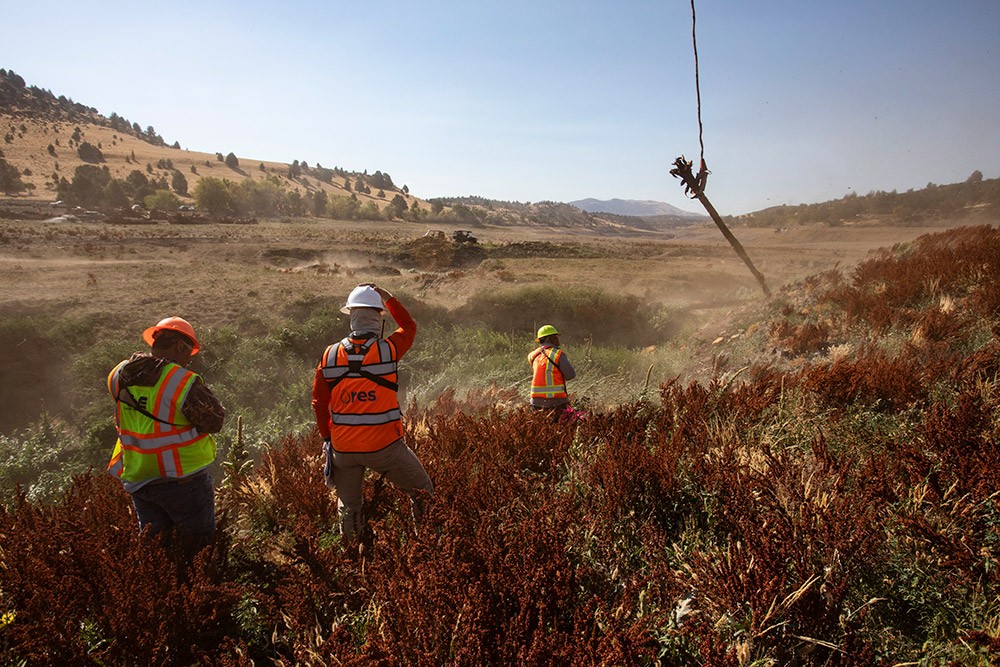ENR 2024 Top 200 Environmental Firms: Making an Epic Transformation
October 10, 2024
ENR 2024 Top 200 Environmental Firms: Making an Epic Transformation
October 10, 2024Ranked firms boost 2023 revenue to new record as energy transition and climate mitigation actions propel need for sector services.
Illustration by Scott Hilling/ENR, original background grid by Getty Images/amtitus; original graph texture by Getty Images/gaiamoments; some original elements courtesy New York Public Library Public Domain Artwork collection.
Related Link:
ENR 2024 Top 200 Environmental Firms
ENR 2024 Top 200 Environmental Firms (PDF)
(Subscription Required)
ENR 2024 Top Green Design Firms and Contractors
Financial, legal and political bumps did not dent the global environmental services market for ENR’s Top 200 Environmental Firms, based on results reported in this year’s ranking.
Ramped-up project spending to address climate change and energy transition urgency, and new infrastructure needs, triggered a list revenue surge—buoyed by company mergers and acquisitions to build workforce size, bottom line strength and technical capacity to execute the growing mission. Top 200 firm executives are watching how—or whether—the upcoming U.S. elections and new global tensions will alter market trajectory, but most are optimistic that other forces will sustain it.
Top 200 firms reported a total of $169.7 billion in global 2023 environmental services revenue, with a clear surge related to the energy transition and a shrinking gap between U.S. and non-U.S. totals, which are $86.8 billion and $82.8 billion respectively. “Antea Group has a bullish outlook on revenue growth in the near term,” says Yde van Hijum, CEO of the Netherlands-based consultant who cites “recent resilience of the U.S. economy and projected growth for environmental and sustainability consulting services in North America.” He sees market risks mitigated by government policies and by more clients improving business resilience by addressing energy transition and decarbonization.
APTIM has “experienced good growth in our traditional environmental services in 2023, driven largely by continued pressures by consumers, employees, investors and shareholders around public ESG [environmental, social and governance] commitments,” says Greg Coffman, the No. 44-ranked firm's senior vice president of environmental and energy solutions.
Jim Giannopoulos, global CEO of Australia-based GHD Group, No. 30, says, “Disclosing climate-related data and information has become a new business imperative mandated by regulators in Australia, Canada, the EU, New Zealand, U.K., USA and a growing list of other countries. These requirements will grow over the next 12 months.”
Worley, which rose ten spots on the 2024 list to No. 24, said its transition to cleaner energy projects continues to yield returns. “Sustainability-related work represents 82% of [our] factored sales pipeline,” CEO and Managing Director Chris Ashton said earlier this year. “Our ambition is [to] be recognized globally as a leader in sustainability solutions.”
Markets Up
Firms working in the air quality and clean energy sector reported $38.76 billion in global revenue—up significantly from $23.16 billion reported last year, and comprising 22.8% of the ranking revenue total—edging out hazardous waste for the first time as the largest Top 200 environmental services sector. Global water supply and treatment revenue rose nearly $10 billion to $34.9 billion, comprising 20.6% of the Top 200 total, from 18.1% last year.
The revenue surge generated new 2024 additions to the Top 200 billion-dollar group based on 2023 revenue, which rose to 31 firms from 20 two years ago. Fifteen Top 200 companies also exceeded $2 billion in reported environmental services revenue, up from ten on last year’s ranking. They include Mortenson, SolvEnergy, Black and Veatch and Stantec, with Bechtel citing energy, air pollution and hazardous waste work in pushing its environmental revenue past $3 billion.
“Energy transition is very strong globally, and we will see it grow quite rapidly,” says Bruce Chalmers, vice president and global environmental market director for No. 4-ranked Jacobs Solutions Inc. “It’s an issue that will take 25 to 40 years to tackle.” He notes that the largest U.S. transmission grid operator, PJM Interconnection, which is in all or part of 13 states and Washington, D.C., has 2,500 requests for new-generation connection, up from 375 in 2017, and mostly for renewable energy projects—amounting to 250 GW of power.
Despite massive efforts by federal and state officials to fast-track U.S. offshore wind energy project approvals to meet ambitious deployment goals, challenges in permitting, supply chain execution and rising costs have slowed sector growth in some areas, with cancellations this year of planned federal lease auctions in the Gulf of Mexico and offshore Oregon. HDR notes the project impacts but emphasizes that port infrastructure investment still “continued to fuel the demand for environmental services in this sector.”
Revenue rose for solar energy contractor SOLV Energy, but firm CEO George Hershman says limited availability of project components “prevented several jobs from being completed within the expected timeline.” With power demand pushed by data center and AI expansion and more industry electrification, “in 2024, we anticipate a 50% increase in revenue over 2023,” he says. The firm also plans to expand beyond EPC services to operations and maintenance, repairs, replacements and repowering.
While the nuclear waste cleanup market shrank on this year’s survey as remediation projects finish, there is growing acceptance, although controversial, of nuclear power as a cleaner global fuel—with plans for two decommissioned U.S. plants to restart operations and for building new advanced facilities that are smaller and seen as safer—which is set to generate a new Top 200 market.
Top 200 List Newcomer | By Debra K. Rubin
RES Takes Project Management Back to Nature

Photo courtesy of Resource Environmental Solutions
‘Growing Pipeline’
Waste management firm Clean Harbors Inc. still sees hazardous waste market growth related to domestic manufacturing accelerated by the CHIPS and Science Act and other legislation. “All of those new or expanded sites are needing our disposal and environmental services,” says the firm, which claims 300,000 customers. It also notes “a growing pipeline of Superfund projects coming to market,” with sector growth also linked to the U.S. Environmental Protection Agency proposal this year to regulate some PFAS "forever" chemicals as hazardous waste. “There are highly favorable underlying business fundamentals and market dynamics for Clean Harbors today and in years ahead,” the firm says.
Alaska-based ASRC sees continued demand for environmental services such as specialty waste remediation, inspection, testing and characterization. “We are already experiencing growth in our federally contracted work. Over the next 12 months, we foresee environmental services … remaining a key component of [ASRC’s] organic and acquisitive growth strategies,” the company says,
ATI Restoration rose more than 90 list spots to No. 101, citing more remediation projects, including those generated from firms it acquired. The company says it “has intensified efforts to hire and train environmental technicians, equipping them to deliver a wide range of services nationwide” that include asbestos and lead abatement, biohazard decontamination and mold remediation for government, commercial and residential clients. “The increased demand for environmental service occupations, driven by workers transitioning careers or leaving the labor force, underscores the need for expanding our environmental workforce,” ATI says.
Despite market optimism, remediation firm TriHydro Corp. pointed to more client caution on project spending. “We were able to negotiate rate increases with many of our larger clients; however, we will need to pursue additional rate increases and lump sum billing models to keep pace with continued wage pressure,” the company said. “We are taking a focused approach to expanding in niche areas that may benefit from increased [government] spending.”
CDM Smith says firm growth last year “was significantly influenced” by EPA rulemaking on PFAS and also by proposed revisions to its Lead and Copper Rule, which requires drinking water system operators to replace service lines within 10 years, starting in 2027, if lead concentrations exceed 10 parts per billion in more than 10% of customers sampled—more strict than the previous 15 ppb limit.
President Joe Biden on Oct. 8 announced a final rule that will require a national service line inventory, with initial steps due by Oct. 16, and expanded removals on residential property and testing in schools. “The company’s expertise in water treatment and environmental management positions it to capitalize on increased demand for services following these regulatory changes … and will continue to drive growth,” says CDM Smith Chairman and CEO Tim Wall. The rule faces legal challenges and a possible legislative block.
But Chalmers at Jacobs Solutions says concern is speculative related to how strongly the U.S. Supreme Court’s Chevron decision earlier this year—which is seen as a possible end or limit to federal agency interpretation of gaps in U.S. law—would affect environmental regulation. “We’re not seeing any reaction from clients in the federal or private space," he told ENR. "Clean water is solid and fundamental. I don’t think it’s going away and there will still be strong growth.”
Top 200 Firm in Focus | By Mary B. Powers
Garney Grows Bottom Line in High-tech Water

Image courtesy of Garney Holding
With a $400-million jump in environmental services revenue last year to $1.83 billion, No. 16-ranked Garney Holding Co. expects the market, especially for water reuse and recycling, to remain strong for the foreseeable future, says David Burkhart, installed this spring as CEO. He sees a confluence of catalysts keeping it robust for the employee-owned, 2,300-person firm—including aging infrastructure that needs repair or replacement and onshoring or reshoring of manufacturing. “It’s all happening at the same time so there’s a lot of demand for water and wastewater treatment and recycling, particularly on the industrial side,” Burkhart says. Municipal work also is up,.
Data centers, battery plants and chip manufacturers are moving to regions of the U.S. that are “in a pinch” for water, which makes recycling and reuse critical, he says. The Missouri-based firm recently finished its largest private industrial installation contract to date, a large-volume greenfield water supply project in Texas that delivers near-pure water to an advanced industrial manufacturing plant, says Burkhart. He did not disclose the owner’s identity, the firm’s engineering partner or cost of the design-build project. It was finished in 18 months, he says, with an extremely aggressive schedule that also included cost savings.
Garney does not own proprietary technology for its projects, but “as a result of our experience with private industry, we’ve been called on to install new technologies as they come on the market,” he says. The company also has two water reclamation projects underway for public utilities, each valued at about $700 million.
With No. 7-ranked Tetra Tech as lead designer and others, Garney is building the $925-million advanced SWIFT water treatment plant in Suffolk, Va. (see above), to cut nutrient discharges into Chesapeake Bay, replenish groundwater and combat sea-level rise. The firm has been self-performing for 60 years, Burkhart says, also doing “unique” federal work and western state mining, power and snowmaking projects. “It takes creative engineering for the high elevation and steep slopes,” he says. Garney is not being pursued for acquisition, nor seeking its own large purchases, Burkhart adds, but it looks for strategic additions to broaden services. “We’ve resisted the urge to move into explosive growth and instead are focusing on responsible and sustainable organic growth to build out a skillset,” he says.
‘Hot’ Water Sector

“We experienced good growth in traditional environmental services driven by [ESG] pressures by consumers, employees, investors.”
—Greg Coffman, Senior Vice President , APTIM
Water and wastewater infrastructure work remains a Top 200 mainstay, with the former’s nearly $35 billion in 2023 Top 200 revenue up from $25 billion last year.
“In 30 years working in this industry, the market for wastewater construction was as hot as I have ever seen it in the second half of 2023,” says Joe Godin, president of American Contracting & Environmental Services Inc., ranked at No. 130. “There were so many opportunities that we were able to be more selective on clients and type of jobs that we pursued.” He says while the firm grew backlog by 30% with profitable work, “this dynamic drove prices above owners’ budgets, which resulted in several jobs where we were low bidder not moving forward.” Godin is optimistic the healthy market will continue, although the election impact remains unclear.
“We see investment levels holding steady, maybe even increasing in the next year,” says Detroit-based design firm Wade Trim, ranked at No. 137. “However, we are concerned about the impacts of inflation on construction costs and the number of projects utilities can afford to implement.” The decreasing number of engineers also “has us considering how we deliver our growing backlog.”
Gresham Smith says 2023 continued the trend of lower technical and craft labor availability, coupled with supply chain issues, “further pinching, but not constricting, the volume of work our clients procure.” Brown and Caldwell agrees, but sees some utilities using federal funds to offset cost hikes of projects.“This unusual combination of forces could spur the growth of the collaborative delivery market, where [the firm] has a strong position,” it says.
Emerging global markets continue as a key water infrastructure market for Cairo-based The Arab Contractors, which is Egyptian-government owned and managed recent projects in that country that include two of the world’s largest wastewater treatment plants, it says. The firm also operates across Africa, noting "significant growth recently, thanks to ambitious development plans of many African countries.”
Among non-U.S. markets for the Top 200 revenue, Europe again tops the list, with listed firms reporting $41 billion in 2023 revenue from work there—although its global market share fell to less than 50% from 56.5% on last year’s ranking. Top 200 list leader Veolia, with 89% of its reported $50.1 billion in environmental services revenue in non-U.S. markets, recently launched its GreenUp 2024-27 strategy to boost decarbonization and water conservation targets for clients and itself. It aims to increase North America revenue by 50% by 2027 and to double U.S.-based revenue by 2030 through organic growth and tuck-in acquisitions.
U.S.-based design-build firm Burns & McDonnell, ranked No. 19, launched an environmental services unit in England to support U.K. engineer-procure-construct work.

“There are many opportunities for innovation” to develop digitally enabled ways to manage the major growth of environmental data volume.
Jim Giannopoulos, Global CEO, GHD Group
The global market share for Asia was 15.7%, rising from 14%. India’s Ministry of New and Renewable Energy announced a $6.2-billion clean energy budget for 2024-25, up from $3.5 billion previously.
S.N. Subrahmanyan, chairman and managing director of Mumbai-based Larsen & Toubro Ltd., ranked at No. 3, says it also is building several large solar energy projects and a 400-MWh battery storage system in Saudi Arabia. Reported Middle East environmental services revenue in 2023 rose to $5.36 billion from $1.97 billion and more than doubled its Top 200 market share to 6.5%. But concern is growing that escalating regional tension could hurt the scope of further market growth.
Technology optimization is a major growth catalyst, with AECOM last month announcing a new “business line” offering data analytics and advanced digital tools for water asset management, environmental permitting and PFAS pollution remediation. Named as unit CEO is former Tetra Tech President Jill Hudkins, who had launched that firm's digital water practice, said AECOM on Sept. 30. She stepped down from the role and the firm in May.
“Advancements in technology have and will continue to affect environmental services and how we deliver for our clients,” says Susan Nichols, New England environmental service leader at VHB (No. 143). Chief Information Officer Greg Bosworth says the firm invested in a specially designed GIS portal for “gathering, storing and referencing pertinent spatial data” to be readily available for its project teams.
GHD’s Giannopoulos sees “many opportunities for innovation” to develop digitally enabled ways to manage the growing volume of environmental data, including predictive models and artificial intelligence. “We are investing in new approaches that go beyond traditional ways to manage information, which can be costly, time-consuming and onerous.”
But he calls for “more global alignment among reporting requirements to eliminate cost and complexity associated with multiple disparate schemes.”
With data management assistance by Jon Keller and Jack McMackin










